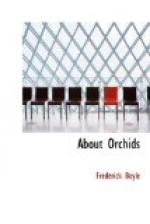B. Beccarii has leaves two feet long, eighteen inches broad. It encircles the biggest tree in one clasp of its rhizomes, which travellers mistake for the coil of a boa constrictor. Furthermore, this species emits the vilest stench known to scientific persons, which is a great saying. But these points are insignificant. The charm of Bulbophyllums lies in their machinery for trapping insects. Those who attended the Temple show last year saw something of it, if they could penetrate the crush around B. barbigerum on Sir Trevor Lawrence’s stand. This tiny but amazing plant comes from Sierra Leone. The long yellow lip is attached to the column by the slenderest possible joint, so that it rocks without an instant’s pause. At the tip is set a brush of silky hairs, which wave backwards and forwards with the precision of machinery. No wonder that the natives believe it a living thing. The purpose of these arrangements is to catch flies, which other species effect with equal ingenuity if less elaboration. Very pretty too are some of them, as B. Lobbii. Its clear, clean, orange-creamy hue is delightful to behold. The lip, so delicately balanced, quivers at every breath. If the slender stem be bent back, as by a fly alighting on the column, that quivering cap turns and hangs imminent; another tiny shake, as though the fly approached the nectary, and it falls plump, head over heels, like a shot, imprisoning the insect. Thus the flower is impregnated. If we wished to excite a thoughtful child’s interest in botany—not regardless of the sense of beauty either—we should make an investment in Bulbophyllum Lobbii. Bulbophyllum Dearei also is pretty—golden ochre spotted red, with a wide dorsal sepal, very narrow petals flying behind, lower sepals broadly striped with red, and a yellow lip, upon a hinge, of course; but the gymnastic performances of this species are not so impressive as in most of its kin.
A new Bulbophyllum, B. Godseffianum, has lately been brought from the Philippines, contrived on the same principle, but even more charming. The flowers, two inches broad, have the colour of “old gold,” with stripes of crimson on the petals, and the dorsal sepal shows membranes almost transparent, which have the effect of silver embroidery.
Until B. Beccarii was introduced, from Borneo, in 1867, the Grammatophyllums were regarded as monsters incomparable. Mr. Arthur Keyser, Resident Magistrate at Selangor, in the Straits Settlement, tells of one which he gathered on a Durian tree, seven feet two inches high, thirteen feet six inches across, bearing seven spikes of flower, the longest eight feet six inches—a weight which fifteen men could only just carry. Mr. F.W. Burbidge heard a tree fall in the jungle one night when he was four miles away, and on visiting the spot, he found, “right in the collar of the trunk, a Grammatophyllum big enough to fill a Pickford’s van, just opening




